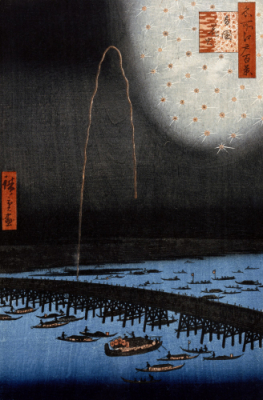For the Sunday before bonfire night, an appropriately incendiary depiction of fireworks by the great Japanese master of woodblock printing Ando Hiroshige. Fireworks over Ryogoku Bridge was part of a famous series of popular prints, collectively entitled One Hundred Famous Views in Edo, which the artist worked on from 1856 until 1858, the year of his death. Hiroshige referred to the sequence as a whole as his “grand farewell performance”, a description which seems to fit the picture reproduced here particularly well.
Edo, now Tokyo, was the city in which Hiroshige was born and worked all his life, although it would be wrong to think of it as a city in the modern, Western sense of the word. Densely built-up areas co-existed with rice paddies, parks and orchards, giving a varied and picturesque effect in which the works of man and nature merged. Unlike typical European cities, Japanese settlements were not traditionally bound by walls, partly because the Japanese had no equivalent to the ancient Western idea that city and country are essentially opposed. Ruled by the Tokugawa shogun, the society of Edo was organised on strict hierarchical principles and run as a virtual police state. A large part of Hiroshige’s market was made up of the urban poor, artisans or unskilled workers who could afford the price of a bowl of noodles for a coloured print to brighten up their lives. Many of the “famous places” that he depicted – meisho in Japanese – were parts of Edo to which such people went for relaxation and release from the strictures of their highly ordered society.
Fireworks over Ryogoku Bridge shows Edo society in holiday mood, gathered at one of its favourite “famous places”, the second largest bridge over the Sumida River and the centre of what was in...


